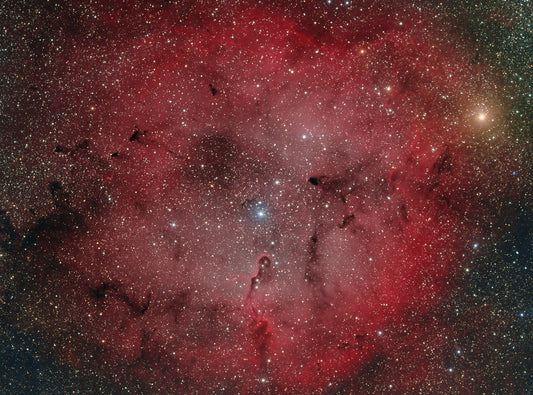SkyFi Quick Start Guide
These instructions assume that you are familiar with your own telescope equipment, and with basic home-networking concepts like SSIDs, WEP security, and IP addresses.
- Turn SkyFi’s Power On
You can power SkyFi from four AA batteries, or from an external DC power source.
- Turn SkyFi’s Power On
- To power SkyFi internally, insert four AA batteries into the battery compartment. Make sure they are oriented correctly. Battery life should be 8 to 10 hours for alkaline batteries under normal operating conditions.
- If you have an external power adapter, plug it into SkyFi’s DC input jack. The input DC power requirements are 6 - 12 Volts, 0.5 - 1.5 Amps. A car battery with an auto cigarette lighter adapter should work fine; SkyFi’s DC input jack accepts any standard center-positive 5.5 mm OD x 2.1 mm ID male barrel plug.
- Now turn on SkyFi. Move the power switch right to the BAT position to use battery power, or left to the EXT position to use external power.
- The status LED should light up red at first, then turn green after a few seconds. If it does not, turn the power off for a few seconds, then turn it on again. See the Troubleshooting section below if the status LED still does not turn green.
When running SkyFi from an external power source, it may become quite warm. This is normal; SkyFi doesn't use any more power than the 6V supplied by the internal battery pack, and it is simply dissipating the extra power as heat. SkyFi's electronics can function properly at temperatures up to 80° C!
Please note: batteries are not included, and AC adapters are available separately.
- Join SkyFi’s Wireless Network
When you turn SkyFi on, it creates an open wireless network named “SkyFi”. Join this network from your PC, Mac, iPhone, iPod, or other wireless device - just as you would join any other WiFi network.
- When you join SkyFi's network, SkyFi will automatically assign an IP address to your computer or other wireless device. For this to work correctly, make sure your computer or mobile device is configured to use DHCP (Dynamic Host Configuration Protocol). This is the default setting on most computers. Consult Mac OS X or Windows Help for more information on how to check your network settings.
- SkyFi generates an “Ad Hoc” wireless network. It is not a router or wireless access point. You will not be able to connect to the internet while joined to SkyFi’s wireless network – only to other devices on SkyFi’s network. If several devices are joined to SkyFi’s network, that network will still exist even if SkyFi itself is turned off! To completely shut down SkyFi’s wireless network, make sure all devices have disconnected from SkyFi’s network – and wait a minute or two for your computer to “forget” the network.
SkyFi can be configured to join an “Infrastructure” wireless network, such as generated by a typical home router. This way, your iPhone, computer, and SkyFi can all be on your home network at the same time, and your computer or iPhone can connect to the internet while simultaneously connected to SkyFi. For information on how to do this, go to our web site, at the URL listed at the top of this page.
- Configure SkyFi’s Wireless Network
You can skip to the next section if you just want to start controlling your telescope. However, we strongly recommend that you change SkyFi’s wireless network name and enable WEP security before using SkyFi in the field. If you don’t, other SkyFi units with the same network name may conflict with yours, and other users may be able to connect with (and control!) your hardware.
To configure SkyFi’s wireless network after you have joined it:
- Launch a web browser, like Safari or Internet Explorer. Browse to http://10.0.0.1/
- You should see a web page which lets you set SkyFi’s network name (SSID), enable WEP security, and enter a WEP key. Your WEP key must contain exactly 10 or 26 hexadecimal characters (digits 0-9, letters A-F). Click the “Save Changes” button when finished.
- Wait a few seconds for SkyFi’s network to reset, then re-join SkyFi’s new wireless network. Browse to http://10.0.0.1/ again to confirm your new network settings.
- Connect Your Telescope
With USB telescopes, use a standard USB cable to connect SkyFi’s USB “A” port to the telescope’s USB “B” port. On Meade LS telescopes, the USB “B” port is on the mount base. With iOptron telescopes, the USB “B” port is on the GOTONova hand controller.
With serial telescopes, you’ll need a serial cable to connect your telescope’s RS-232 port to a standard PC DB9 Male serial port. Different telescopes require different serial cables. Contact your telescope manufacturer to obtain the correct serial cable for your telescope.
- Connect your telescope serial cable to the RS-232 port on your telescope. On most telescopes, the RS-232 port is a 4- or 6-wire modular (“telephone”) jack. On Meade LX-200 and LX-400 telescopes, the RS-232 port is located on the mount base. On almost all others (e.g. Meade telescopes with #497 AutoStar controllers, Celestron telescopes with NexStar controllers, Orion and SkyWatcher telescopes with Synta controllers), the RS-232 port is located on the bottom of the hand controller. See note below.
- Connect the other end of your telescope’s serial cable to the DB9 male connector on SkyFi’s serial adapter. Insert the other end of the serial adapter into SkyFi’s RJ-11 serial connector. Make sure the connector clicks into piace securely.
- Turn on your telescope, and perform any telescope alignment procedures that you would normally perform. See your telescope user manual for instructions on how to align your telescope.
IMPORTANT: Do not connect SkyFi to the AUX port, handbox port, autoguider port, or any port on your telescope (or its hand controller) other than its RS-232 serial port. Doing so may damage SkyFi and/or your telescope hardware. Make sure you know where the RS-232 serial port on your telescope is located, and only connect SkyFi to that port.
You don’t need to use the mini null-modem adapter supplied with SkyFi when connecting it to a telescope. This null-modem adapter is only needed when connecting SkyFi to a PC serial port for firmware updates. See our web site for details.
You can attach SkyFi to your telescope’s mount or tripod with the supplied strip of Velcro. Make sure SkyFi’s serial adapter is not kinked, that there is a decent amount of slack in your telescope serial cable, and that all connectors are fastened securely.
- Control Your Telescope
These instructions assume you are running SkySafari appon an iPhone, iPad, or iPod Touch, or SkySafari for Mac OS X on a Mac.
- If you’re running SkySafari version 2.0 or higher on an iPhone, iPad, or iPod Touch, go to Settings > Telescope Communication. Select the correct telescope type. Enter SkyFi's IP address and port number. By default, these are 10.0.0.1 and 4030. Tap the Done button to accept changes and return to the main sky chart view. Tap the Scope button on the bar below the sky chart view. Tap the Connect button to establish communication with your telescope. If successful, the telescope’s position should appear as a bullseye on the star chart.
- If you’re running SkySafari for Mac OS X version 1.0 or higher on a Mac, select the Telescope menu > Setup... Select the correct telescope type. Select "WiFi or Ethernet (TCP/IP)" as the Communication Port. A text field will appear, where you can enter SkyFi's IP address and port number. By default, these are 10.0.0.1 and 4030, so enter those values. Click the OK button to connect to your telescope. If everything is working, the Telescope control panel should appear.
Troubleshooting
- If the status light does not turn on, or does not turn green, the batteries are probably low. If the problem persists despite using fresh batteries or external power, contact Simulation Curriculum for help.
- When SkyFi is sending or receiving wireless data, the green status LED will blink. If the green LED does not blink when you try to join SkyFi’s network, or when you try to connect to your telescope, then you probably joined the wrong WiFi network, or entered the wrong WEP key. Make sure there are no nearby WiFi devices with conflicting network names (like other SkyFi units, or computers/iPhones which were previously joined to SkyFi’s network).
- If you’ve forgotten your SkyFi network SSID or WEP key, poke the reset button on the back of the case with a ballpoint pen or an unbent paperclip. This will restore SkyFi’s “factory default” settings. You can then re-configure your SkyFi unit as per above.
- By default, SkyFi’s IP address is 10.0.0.1, and it should assign an IP address to your computer or iPhone that is in the range 10.0.0.2 – 10.0.0.100. Check your computer’s TCP/IP network settings to verify that your computer’s IP address is in this range. If not, make sure your computer/iPhone is using DHCP. Also try renewing your DHCP lease.
- If you can’t connect to your telescope, make sure all cables are connected correctly to the RS-232 port on your telescope’s hand controller or mount base, and not to the AUX port, HBX port, autoguider port, etc.
- Make sure you’re using the correct serial cable combination for your telescope. A Celestron NexStar serial cable will not work with a Meade Autostar hand controller – even though it will physically fit into the Autostar’s RS-232 jack – or vice-versa.
- Make sure cables are connected securely, and not kinked or bent. Make sure everything is turned on. Make sure your telescope control application is configured to use SkyFi’s correct IP address and port number.
- If you are running on a Mac or PC, other software on your computer may be blocking its network connection to SkyFi. Firewalls, anti-virus, and web or e-mail proxy software are likely culprits. Try turning them off, then browse to http://10.0.0.1/ to see if you can view SkyFi's configuration web page. If not, something else is blocking network access to SkyFi.
- Many telescopes will not respond to some (or all) external commands until they have been star-aligned. Did you remember to star-align your telescope before connecting with SkyFi?
- Celestron NexStar and Meade Autostar controllers may not accept “GoTo” commands until the scope been star-aligned. They will refuse to GoTo coordinates which they think are below the horizon. Is your telescope’s location/date/time set correctly?
- Orion and SkyWatcher telescopes with SynScan controllers must not be in "PC-DIRECT" mode to accept external commands. Other models need to be in "RS-232 mode" to accept commands; check your telescope owner's manual for details.
- If you can connect, but experience frequent communication dropouts, try replacing SkyFi's batteries, or using external power. Also make sure your iPhone/iPad/iPod battery is well charged. If you are operating SkyFi in an environment with many nearby wireless networks, 2.4 GHz cordless phones, and/or many reflective metal surfaces, WiFi interference may be a problem.
- Flaky communication can also be caused by a loose cable or connector; make sure all cables and connectors are fastened securely.
- If SkyFi’s green status light is blinking, but you are not running our app or otherwise communicating with a telescope, then other nearby iPhones or computers may have joined SkyFi’s network. This can cause interference, and is a good reason to protect your SkyFi network with WEP.
- If you have an iPhone 3G or 3GS, go to the main iPhone Settings app, then to the General > Network section, and turn OFF the "Enable 3G" switch. The 3G network seems to bring down the iPhone's WiFi interface periodically. Turning this switch OFF and ON again may clear the problem.
- If all else fails, turn SkyFi’s power off, wait a few seconds, then turn it on again. Rejoin SkyFi’s network, then restart your telescope control application.
- If you are running on a Windows laptop, try updating your laptop’s WiFi driver software. For example, HP laptops with Broadcom 43255 WiFi chipsets are known to disconnect frequently; updating to driver version 5.60.48.35 solves this problem.
- If SkyFi works OK on external power but not batteries, change the batteries (all of them!) Make sure the batteries are inserted in the correct (+ and -) polarity orientation. If SkyFi is still not working on batteries, use a small electronics-sized Philips screwdriver to open the case. Inspect the wires going to the battery clips to make sure they have not become un-soldered. You can try re-soldering them yourself, or you can return it to Simulation Curriculum for repair.
|
This device complies with Part 15 of the FCC Rules. Operation is subject to the following two conditions: (1) this device may not cause harmful interference; and (2) this device must accept any interference received, including interference that may cause undesired operation. |
Blog posts
View all-

The Elephant Trunk Nebula
The Elephant Trunk Nebula, a stunning dark nebula, perfect for visual and photographic capture. By Richard Wright (www.eveningshow.com)
The Elephant Trunk Nebula
The Elephant Trunk Nebula, a stunning dark nebula, perfect for visual and photographic capture. By Richard Wright (www.eveningshow.com)
-

Chasing a Comet at Dawn and by Day
Incoming Comet Tsuchinshan-ATLAS promises to provide a fine show, starting first with a brief appearance at dawn in late September.
2 commentsChasing a Comet at Dawn and by Day
Incoming Comet Tsuchinshan-ATLAS promises to provide a fine show, starting first with a brief appearance at dawn in late September.
2 comments -

SkySafari Now Featuring StarSense Explorer Scop...
StarSense Explorer scope owners can now seriously supercharge their astro experience...
SkySafari Now Featuring StarSense Explorer Scop...
StarSense Explorer scope owners can now seriously supercharge their astro experience...



